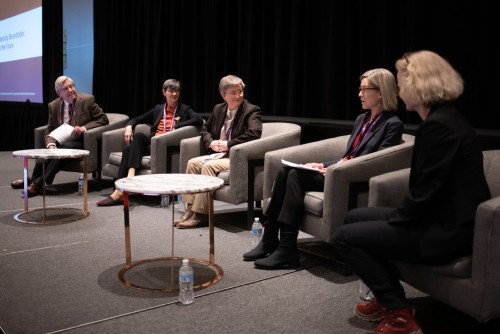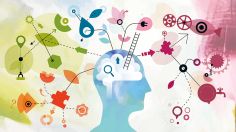Dr. Walter J. Koroshetz has been fascinated by the brain and how it works from a young age. This curiosity, sparked by a chance encounter with a book on psychiatry, inspired a successful career in neurology and neuroscience. Now he leads the National Institute of Neurological Disorders and Stroke (NINDS), a driving force behind brain research in the United States. Dr. Koroshetz spoke with NIH MedlinePlus Magazine about his passion for the brain, his path to NINDS, and how The Brain Research Through Advancing Innovative Neurotechnologies® Initiative, or the BRAIN Initiative®, is transforming how we understand the brain.
Tell us about your background and why you decided to study the brain.
I grew up in Brooklyn, New York, and became interested in the brain in eighth or ninth grade. I was curious about why people are so different. I went to the library one rainy day and picked up the biggest book I could see, which was a book on psychiatry. The first chapter was about how cells in the brain communicate through the movement of ions across the membranes that enclose nerve cells. This aspect of biology fascinated me, and I spent years working in membrane biology labs.
Also, my dad got very sick with Guillain-Barré syndrome (a rare and serious condition that affects the nerves causing paralysis). He was in the hospital for about six months. Luckily he made it out. I’m sure that also had something to do with my interest in the brain and nervous system.
You joined NINDS in 2007. How did you get here?
It was very serendipitous. I had been a neurologist and neuroscientist at the Massachusetts General Hospital (MGH) in Boston for 27 years. I was at a point in my career where I was being considered for chair of departments and was offered a couple of positions. I spoke with a friend and colleague who had left MGH to become a chair at another university. It turns out his wife was Story Landis, Ph.D., who was the Director of NINDS at the time. My friend said, “I have a better job for you!” And that was true. I came on as a Deputy Director at NINDS with Dr. Landis, and I’m glad I did. It wasn’t planned, it just happened. (Editor’s note: Dr. Koroshetz became NINDS Director when Dr. Landis retired in 2014.)
The brain is a unique organ. It is both functional (it controls motor skills, breathing, and other bodily processes) and psychological (it’s responsible for our intellect, memory, personality, and mood). What’s something you wish more people understood about the brain?
There is nothing that we do or experience that doesn't involve our brain. If the brain is not working, behaviors are not going to be normal. Sometimes we are quick to blame the dysfunctional behavior on the person when there is a brain disorder. This can create a great deal of stigma and hinder needed treatment.
There are a lot of disorders where the brain circuits are severely affected. It’s important to understand that these are all disorders whether you can see something under a microscope or not.
"There is nothing that we do or experience that doesn't involve our brain...Sometimes we are quick to blame the dysfunctional behavior on the person when there is a brain disorder."
How does NINDS collaborate with other institutes that deal with the brain, like the National Institute of Mental Health (NIMH), and what sets NINDS apart?
Neuroscience itself is a huge area of focus here at NIH, and it’s funded by different institutes. The National Institute on Aging researches Alzheimer’s disease, and NINDS works with them on that and other neurodegenerative diseases. We also work with the National Institute on Drug Abuse (NIDA). Drugs such as opioids change the circuits in the brain, so addiction is really a brain problem, too. We closely collaborate with NIDA on the Helping to End Addiction Long-term® Initiative, or NIH HEAL Initiative®: We focus on pain, and they work on addiction.
Neurologists think of mental health as neurological disorder without a known cause. These are all brain disorders, but in neurology, we tend to focus on the pathology inside the brain—something you can see under a microscope. However, even in those cases the patient is always suffering from a dysfunctional circuit. In psychiatry, it’s been hard to identify the circuit trouble because there's nothing to see in the brain—it’s not anything you can look at under a microscope.
The problems you see in people who have neurological, mental, and substance misuse disorders happen because something is interrupting the circuit’s development or function. That’s why the BRAIN Initiative is so important. It’s run by multiple institutes but primarily NINDS and NIMH, and it’s focused on understanding how to map, monitor, and modulate (change or alter) circuits in the brain. The BRAIN Initiative is really merging the fields of neurology and psychiatry.

Dr. Koroshetz (far left) joins other NIH institute directors at the 5th Annual HEAL Initiative Scientific Meeting.
The BRAIN Initiative is now in its 11th year, and you’ve been at NINDS since it started. What would you say are some of the most important findings or discoveries from that initiative?
The BRAIN Initiative was a great idea when the White House first announced it in 2013, but it has really defied all expectations. There have been so many amazing advances.
The biggest breakthrough was being able to barcode and sequence the RNA of individual brain cells. This allowed scientists to identify and categorize different types of cells very quickly and efficiently, which made it possible to create a library of all different cell types in animal and human brains. (A cell type is a way of categorizing the cell based on its specific features and functions in the body).
Next, BRAIN Initiative researchers began analyzing brain tissue of deceased individuals to find unique patterns of gene expression (how genes are turned on and off) in different cell types. This is an unbelievable advance and is being used now to study a host of brain diseases.
Once you know a cell’s type, you can look for changes in its current state. These snapshots tell us how the cell is functioning at a point in time, which can help us find changes associated with a specific disease. For example, looking at a population of dopamine neurons in the brain of someone with Parkinson’s disease and scientists can observe a range of states, or health statuses. You might see some that just died, some that are stressed or dysfunctional and may die soon, and others that are healthy and functional. Being able to see this all at once is a powerful tool for uncovering what's causing these cells to die.
Next, it turns out that you can also identify parts of the genome called “promoters” or “enhancers”, which regulate when, where, and how much a certain gene is expressed. By attaching engineered genes to these promoters and enhancers, we can make changes in specific cell types in a precise manner. In mice, scientists use this method to turn nerve cells on or off (make them fire or stop firing) and change sick cells into healthy ones. The challenge is figuring out how to effectively deliver these treatments to the human brain. The BRAIN Initiative is working on that, too. Together, all of this is going to change how we treat brain diseases.
NINDS is at the forefront of using new technologies to study the brain. What technology are you personally excited about and why?
It’s another tool that came out of the BRAIN Initiative: optogenetics. Scientists can add genes from algae into brain cells, which makes the cells produce proteins that react to light. By shining light on these cells, we can turn them on or off. This allows us to manipulate specific cells within the brain circuit of an animal that’s alert and active. Other genes make the cell light up when it’s active, so we can see which cells fire during a certain behavior.
Every time you do something, cells fire all over the brain because they are interconnected. Before the BRAIN Initiative, scientists used electrodes to study brain activity, but they could only monitor a few neurons during an activity. With these new technologies, we can record millions of neurons at a time.
Currently, these tools are only used in animal research. The next step is to move to using them to understand behaviors in humans.
How could these technologies be used to treat neurological disorders or improve overall health?
Lots of ways. For example, there are areas deep in the brain related to pain. If you stimulate those areas, you take the pain away. Researchers are already using electrical stimulation techniques to treat conditions like Parkinson's disease, depression, and chronic pain. They’re developing a process where you stimulate the brain to make symptoms, like muscle stiffness or tremor, stop. But this technique is not nearly as precise as what we can do with the technologies BRAIN Initiative researchers are currently using in mouse models.
"The real credit goes to the patients I’ve been privileged to care for...and the participants who were involved in the research."
Are there any other aspects of your work that you would like to highlight for people?
The real credit goes to the patients I’ve been privileged to care for throughout my career and the participants who were involved in the research. They’re the ones really doing the work, and they deserve the credit.
At NIH, most of the patient work happens in research studies with thousands of participants. And even with all the advances we have, for every person we save there are still thousands we don't have treatment for. We're still working for them, trying to go one by one. But I think the future is looking a lot brighter.
How do you unwind from work to give your brain a break?
I go to the park with my two-year-old grandchild and help him down the slide. It’s a lot of fun being a two-year-old again.
Brain Research Through Advancing Innovative Neurotechnologies® Initiative, The BRAIN Initiative®, NIH HEAL Initiative, and Helping to End Addiction Long-term are registered trademarks of the U.S. Department of Health and Human Services.







